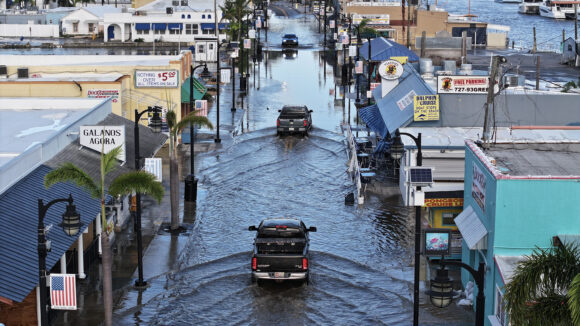Hurricane Milton is on track to become a catastrophic Category 5 storm as it rakes Mexico’s Yucatan Peninsula on a path toward Florida’s western coastline, where evacuations are underway in a region still recovering from Helene’s devastation.
The storm’s top winds have reached 155 miles (250 kilometers) per hour, just below the threshold for a Category 5 hurricane, the US National Hurricane Center said in an advisory at 10 a.m. local time. Its intensity has more than doubled in the past 24 hours.
Related: CoreLogic Increases Total Insured Loss Estimate From Hurricane Helene to $10.5B-$17.5B
Widespread power outages are likely and a small shift in Milton’s trajectory can determine whether it strikes a densely populated area or not, said Florida Governor Ron DeSantis, who has declared an emergency in 51 counties.
“Please, if you are in the Tampa Bay area, you need to evacuate,” Kevin Guthrie, the director of the Florida Division of Emergency Management, said at a briefing Monday. “Drowning deaths due to storm surge are 100% preventable if you leave.”
It isn’t clear exactly where Milton will make landfall. Various computer forecast models are at odds and the hurricane center says errors of as much as 100 miles are possible in the days before a storm comes ashore. Milton will likely make landfall between 5 p.m. and 9 p.m. Wednesday, said Tyler Roys, a meteorologist with AccuWeather Inc.
“Milton’s remarkable rapid intensification is continuing,” Eric Blake, a forecaster at the hurricane center, wrote in his outlook. Only two other hurricanes — Wilma in 2005 and Felix in 2007 — have strengthened as quickly, he added.
Hurricane Milton’s jump in strength comes from hot Gulf of Mexico waters that also intensified the deadly Helene less than two weeks ago. Roys said a ridge of high pressure that’s setting temperature records in Phoenix and across the Southwest is helping steer Milton on an unusual track from west to east across the Gulf. No storm has blazed such a path since 1900.
There is a lot of uncertainty in damage models for Milton on both the high and low ends, with an average estimate of about $35 billion in impacts, said Chuck Watson, a disaster modeler at Enki Research. There’s a chance that Milton will encounter dry air and unfavorable wind conditions as it nears the coast, which could weaken it further and keep losses down.
Related: Biden to Deploy 1,000 Troops to Aid North Carolina After Helene
In addition to packing ferocious winds, Milton is forecast to push a wall of water on shore than may reach as high as 12 feet (3.7 meters) in Tampa Bay and along the coast, including Bradenton and Sarasota, the hurricane center said.
“There is an increasing risk of life-threatening storm surge from Milton for portions of the west coast of the Florida Peninsula beginning Tuesday night or early Wednesday,” the hurricane center said. “Residents should follow any advice given by local officials and evacuate if told to do so.”
NASA and SpaceX have postponed Thursday’s launch of the agency’s multibillion-dollar Europa Clipper mission to explore Jupiter’s icy moon. The agency and SpaceX have launch opportunities until Wednesday, Nov. 6.
Milton will be the second major storm to strike Florida in less than two weeks and the fifth hurricane to hit the US this year. At least 227 people died when Hurricane Helene struck Florida’s Big Bend area in late September and then spread flooding rains into Appalachian Mountains, wreaking havoc across the region. Nearly half of all hurricane deaths come from drowning caused by storm surge and inland flooding.
Related: Hurricane Helene Halts Poultry Plants, Damages Cotton Crops
Milton threatens to inflict wind damage in the northern two-thirds of Florida’s citrus belt this week, according to Commodity Weather Group. For the second time in two weeks, Amtrak has canceled some trains in Florida and halted others at Jacksonville, the federally funded rail carrier said.
Top photo: Flood waters on the main street after Hurricane Helene passed. Hurricane Milton is on track to become a catastrophic Category 5 storm on a path toward Florida’s western coastline, where evacuations are underway in a region still recovering from Helene.
Was this article valuable?
Here are more articles you may enjoy.


 Jane Street-Millennium Trade Secrets Fight Ends in Settlement
Jane Street-Millennium Trade Secrets Fight Ends in Settlement  New York Considers Making Property Insurers Cover Taxi Claims Losses
New York Considers Making Property Insurers Cover Taxi Claims Losses  CVS Accused of Illegal Opioid Dispensing in Whistleblower Suit
CVS Accused of Illegal Opioid Dispensing in Whistleblower Suit  Consulting Firm McKinsey to Pay $650M to Resolve Criminal Opioid Probe
Consulting Firm McKinsey to Pay $650M to Resolve Criminal Opioid Probe 